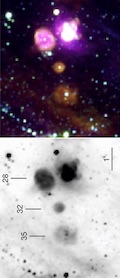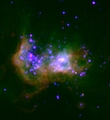



The Local Group as an Astrophysical Laboratory for Massive Star Feedback (Review)
M.S. OeyThe feedback effects of massive stars on their galactic and intergalactic environments can dominate evolutionary processes in galaxies and affect cosmic structure in the Universe. Only the Local Group offers the spatial resolution to quantitatively study feedback processes on a variety of scales. Lyman continuum radiation from hot, luminous stars ionizes \hii\ regions and is believed to dominate production of the warm component of the interstellar medium (ISM). Some of this radiation apparently escapes from galaxies into the intergalactic environment. Supernovae and strong stellar winds generate shell structures such as supernova remnants, stellar wind bubbles, and superbubbles around OB associations. Hot ($10^6$ K) gas is generated within these shells, and is believed to be the origin of the hot component of the ISM. Superbubble activity thus is likely to dominate the ISM structure, kinematics, and phase balance in star-forming galaxies. Galactic superwinds in starburst galaxies enable the escape of mass, ionizing radiation, and heavy elements. Although many important issues remain to be resolved, there is little doubt that feedback processes plays a fundamental role in energy cycles on scales ranging from individual stars to cosmic structure. This contribution reviews studies of radiative and mechanical feedback in the Local Group. 2003, in The Local Group as an Astrophysical Laboratory, eds. M. Livio et al., (Cambridge: Cambridge U. Press), in press.
|

